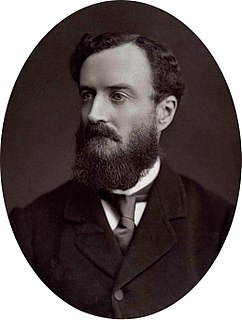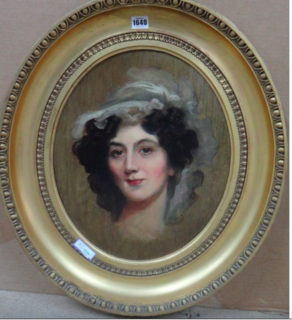
Earl of Iddesleigh, in the County of Devon, is a title in the Peerage of the United Kingdom. It was created in 1885 for the Conservative politician Sir Stafford Northcote, 8th Baronet, of Pynes in the parish of Upton Pyne near Exeter in Devon and lord of the manor of Iddesleigh, 28 miles north-west of Pynes. He served as President of the Board of Trade, Secretary of State for India, Chancellor of the Exchequer, First Lord of the Treasury and Foreign Secretary and was Joint Leader of the Conservative Party from 1881 to 1885. Northcote was made Viscount St Cyres, of Newton Saint Cyres in the County of Devon, at the same time he was given the earldom. This title is also in the Peerage of the United Kingdom.

Earl St Aldwyn, of Coln St Aldwyn in the County of Gloucester, is a title in the Peerage of the United Kingdom. It was created in 1915 for the prominent Conservative politician Michael Hicks Beach, 1st Viscount St Aldwyn, known from 1854 to 1907 as Sir Michael Hicks Beach, 9th Baronet, of Beverston. He was Chancellor of the Exchequer from 1885 to 1886 and again from 1895 to 1902. Hicks Beach had already been created Viscount St Aldwyn, of Coln St Aldwyn in the County of Gloucester, in 1906, and was made Viscount Quenington, of Quenington in the County of Gloucester, at the same time he was given the earldom. Both titles are in the Peerage of the United Kingdom. He was succeeded by his grandson, the second Earl, the son of Michael Hicks Beach, Viscount Quenington, Member of Parliament for Tewkesbury, who was killed in action in 1916. Lord St Aldwyn was also a Conservative politician and was Captain of the Honourable Corps of Gentlemen-at-Arms between 1958 and 1964 and 1970 and 1974. As of 2018 the titles are held by his eldest son, the third Earl, who succeeded in 1992.

Baron Farnham, of Farnham in the County of Cavan, is a title in the Peerage of Ireland. It was created in 1756 for John Maxwell, who had previously represented Cavan Borough in the Irish House of Commons. John Maxwell's son, the second Baron, was created Viscount Farnham in 1760 and Earl of Farnham in 1763. Both titles were in the Peerage of Ireland but became extinct when he died childless in 1779. His brother and successor, the third Baron, was again created Viscount Farnham in 1781 and Earl of Farnham in 1785. These titles were also in the Peerage of Ireland. His son, the second Earl, sat in the House of Lords as an Irish Representative Peer from 1816 to 1823. However, he had no children and on his death in 1823 the viscountcy and earldom became extinct.

Baron Henley is a title that has been created twice: first in the Peerage of Great Britain and then in the Peerage of Ireland. The first creation came in 1760 in favour of Sir Robert Henley, Lord High Chancellor of Great Britain, when he was created Lord Henley, Baron of Grainge, in the County of Southampton. In 1764 he was further honoured when he was made Earl of Northington. On the death of his son, the second Earl, both titles became extinct. Lady Elizabeth Henley, youngest daughter of the first Earl and co-heiress of the second Earl, married the diplomat Morton Eden. In 1799, the Henley title was revived when Eden was created Baron Henley, of Chardstock in the County of Dorset, in the Peerage of Ireland. Their son, the second Baron, assumed the surname of Henley in lieu of Eden and notably published a biography of his maternal grandfather. His son, the third Baron, sat as Liberal Member of Parliament for Northampton. In 1885 the Northington title was also revived when he was created Baron Northington, of Watford in the County of Northampton, in the Peerage of the United Kingdom. This title gave the Barons an automatic seat in the House of Lords. The fourth baron Frederick Henley was an educated man who served as JP in Northamptonshire and married Augusta, daughter of Herbert Langham 12th baronet.

Baron Biddulph, of Ledbury in the County of Hereford, is a title in the Peerage of the United Kingdom. It was created on 1 August 1903 for the banker and politician Michael Biddulph. He was a partner in the London banking firm of Cocks, Biddulph and Co and also sat in the House of Commons for Herefordshire as a Liberal from 1868 to 1885 and for Ross from 1885 to 1900 as a Liberal Unionist. His father Robert Biddulph had previously represented Hereford in Parliament while his younger brother Sir Robert Biddulph was Governor of Gibraltar. As of 2017 the title is held by the first Baron's great-great-grandson, the fifth Baron, who succeeded his father in 1988. In 1978 he assumed the additional surname of Maitland, which is the maiden surname of his mother, Lady Mary Helena Maitland, granddaughter of Ian Colin Maitland, 15th Earl of Lauderdale. She is a Patroness of the Royal Caledonian Ball.

Earl of Breadalbane and Holland is a title in the Peerage of Scotland. It was created in 1681 for Sir John Campbell, 5th Baronet, of Glenorchy, who had previously been deprived of the title Earl of Caithness. He, as a principal creditor, had acquired the estates of George Sinclair, 6th Earl of Caithness who had died heavily in debt and without issue in 1670. Campbell was consequently created Earl of Caithness in 1673, but after much litigation and even bloodshed, George Sinclair of Keiss, second son of George, 5th Earl of Caithness, recovered the estates, and successfully petitioned parliament regarding the earldom, which was removed from Campbell. Sinclair's title was finally restored to him in 1681. Deprived by parliament of the Caithness earldom, Sir John Campbell was created Lord Glenorchy, Benederaloch, Ormelie and Weick, Viscount of Tay and Paintland, and Earl of Breadalbane and Holland on 13 August 1681, with the precedency of the former patent and with the power to nominate any of his sons by his first wife to succeed him. The titles were created with remainder to the heirs male of the son chosen to succeed him, failing which to the heirs male of his body, failing which to his own heirs male, failing which to his heirs whatsoever. The "of Holland" part of the title derived from the fact that Campbell was the husband of Lady Mary Rich, daughter of Henry Rich, 1st Earl of Holland.

Sir William Knighton, 1st Baronet, was Private Secretary to the Sovereign under George IV (1822–1830).
There have been 19 baronetcies created for persons with the surname Campbell, seven in the Baronetage of Nova Scotia and twelve in the Baronetage of the United Kingdom.

Sir Francis Edwards, 1st Baronet, commonly known as Frank Edwards, was a British Liberal Party politician.

There have been twelve baronetcies created for people with the surname Scott, one in the Baronetage of England, two in the Baronetage of Nova Scotia, and nine in the Baronetage of the United Kingdom.
There have been two baronetcies created for members of the Blackett family, both in the Baronetage of England. One creation is extant as of 2013. The Blackett family can be traced back to the Blacketts/Blakheveds of Woodcroft, County Durham, some of whom became highly successful in the lead and coal mining industries in Northumberland and County Durham.

The Williams-Wynn Baronetcy, of Gray's Inn in the County of Middlesex was created in the Baronetage of England on 6 July 1688 for William Williams, a prominent Welsh politician and lawyer from Anglesey, Wales.

The Gibson, later Gibson-Carmichael, later Gibson-Craig-Carmichael Baronetcy, of Keirhill in the County of Edinburgh, is a title in the Baronetage of Nova Scotia. It was created on 31 December 1702 for Thomas Gibson, with remainder to his heirs male. The sixth Baronet assumed the additional surname of Carmichael. The eleventh Baronet was a Liberal politician. In 1912, he created Baron Carmichael, of Skirling in the County of Peebles, in the Peerage of the United Kingdom. The barony died in 1926, while he was succeeded in the baronetcy by his kinsman Sir Henry Thomas Gibson-Craig-Carmichael, 5th Baronet, of Riccarton, who became the twelfth Baronet of Keirhill and assumed the additional surname of Carmichael.
The Dillington Baronetcy of Knighton, Isle of Wight in the County of Hampshire was created in the Baronetage of England on 6 September 1628 for Robert Dillington, who was a Member of Parliament. He was succeeded by his grandson, and then by the three sons of the second baronet in turn. All the Dillington baronets except Sir John followed the first baronet into Parliament. The baronetcy became extinct on the death of the 2nd baronet's last son, Sir Tristram, 5th Baronet in 1721.
Sir William Knighton (1776–1836) was Private Secretary to the Sovereign, George IV.

Dorothea Lady Knighton (1780–1862) was an artist who wrote the Memoirs of Sir William Knighton, Bart, GCH, Keeper of the Privy Purse during the reign of His Majesty King George the Fourth. Including his correspondence with many distinguished persons. She married William Knighton, who would become surgeon to King George IV and executor of his will. She had four children, two daughters and two sons. Her eldest child, a son, died in infancy.
Sir Tristram Dillington, 5th Baronet of Knighton, Isle of Wight was a British Army officer, landowner and Whig politician who sat in the House of Commons between 1707 and 1721.













